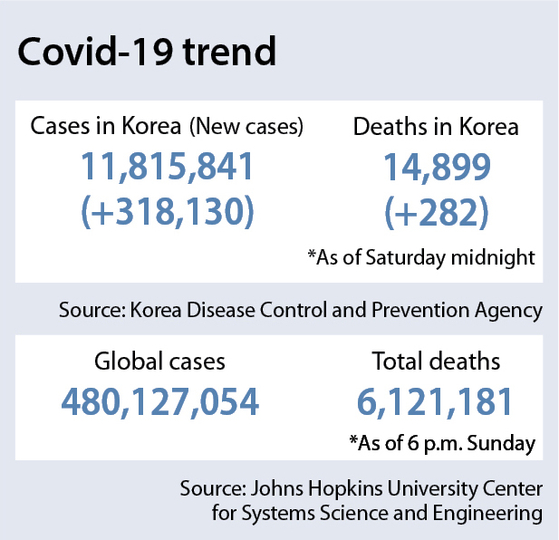Half of Covid-19 deaths in Korea reported this year
![A parking lot in Goyang, Gyeonggi, is packed with funeral cars and coaches on Sunday as Korea weathers the worst wave of the Covid-19 pandemic and a spike in new cases and deaths. [NEWS1]](https://koreajoongangdaily.joins.com/data/photo/2022/03/27/4d5df6c2-a6f3-4b18-82c2-620e4f163f55.jpg)
A parking lot in Goyang, Gyeonggi, is packed with funeral cars and coaches on Sunday as Korea weathers the worst wave of the Covid-19 pandemic and a spike in new cases and deaths. [NEWS1]
The Covid-19 death count is climbing rapidly in Korea, with more than half of total Covid-19 deaths reported within the past three months.
A total of 14,899 people have died of Covid-19 in Korea, at a death rate of 0.13 percent, since the onset of the pandemic in 2020, according to the Korea Disease Control and Prevention Agency (KDCA) on Sunday. More than half of those deaths, or 62 percent, were recorded this year.
Korea has been weathering its worst wave of the Covid-19 pandemic, with the number of new infections of both Omicron and Stealth Omicron, a subvariant of Omicron, shooting up recently.
The daily count hit a record on March 17 at 621,328, and has fallen slightly to the 300,000s for the last four days in a row. The daily numbers in Korea have also been the highest in the world for three consecutive weeks, according to the World Health Organization last week.
A good portion of the newly infected patients and deaths are people aged over 60.
Korea added 318,130 new cases on Saturday, of which 20.9 percent were aged 60 or above. It was the first time in three months that those aged 60 or above accounted for more than a fifth of new cases.
The last time the index broke through the 20-percent mark was in late November, when the Delta variant was the dominant strain in Korea. The Omicron variant became the dominant strain in Korea starting in late January. Before the number of Omicron cases started rising, the percentage of new patients aged over 60 had dropped from 38.7 percent on Nov. 28 to 7.1 percent on Jan. 25.
Experts have pointed to mass infections taking place at long-term convalescent hospitals and nursing homes as one of the major reasons for the spike.
“It is true that long-term convalescent hospitals and nursing homes are struggling the most right now,” said Park Hyang, a senior-ranking official at the Central Disaster Management Headquarters, an inter-ministry body created to address the Covid-19 response in Korea, during a press briefing on Friday at the government complex in Sejong.
“We’re seeing the number of confirmed cases at these facilities increasing, including their medical personnel,” Park said. “We’re trying our best to support them with increased medical personnel and other means.”
The spike in infections among those aged 60 or above havse also resulted in a spike in deaths among Covid-19 patients in this age group. A total of 282 people died on Saturday, of whom 96.8 percent were aged over 60, according to the KDCA.
Over the span of the week from March 11 to 17, a total of 1,835 people died due to Covid-19, of whom 35.3 percent were patients at long-term convalescent hospitals or nursing homes for the elderly, according to the KDCA.
The trend comes despite the high rate of vaccination among people in this age group. According to the KDCA, 89 percent of the population aged over 60 have received booster shots.
Health authorities are hoping the peak of the wave driven by the Omicron variant has passed.

“Although this is not clear, we are looking at it with hope that the peak was reached last Thursday [March 17], when we had around 620,000 cases,” said Lee Gi-il, senior official of the Health Ministry, in a press briefing in Sejong on Friday. “The BA.2, or Stealth Omicron, cases will be coming in the future, and we are monitoring closely how that will turn out. I’d say we have, at the moment, entered a downtrend in the new infection counts.”
The Stealth Omicron variant, which is 1.5 times more infectious than its predecessor, was responsible for 41.4 percent of coronavirus infections in Korea in the third week of March, increasing by 15 percentage points from the week before, according to the KDCA.
As of Saturday, a total of 11.81 million people in Korea, or 22 percent of the total population, had been infected with Covid-19.
BY SHIN SUNG-SIK, ESTHER CHUNG [chung.juhee@joongang.co.kr]










with the Korea JoongAng Daily
To write comments, please log in to one of the accounts.
Standards Board Policy (0/250자)